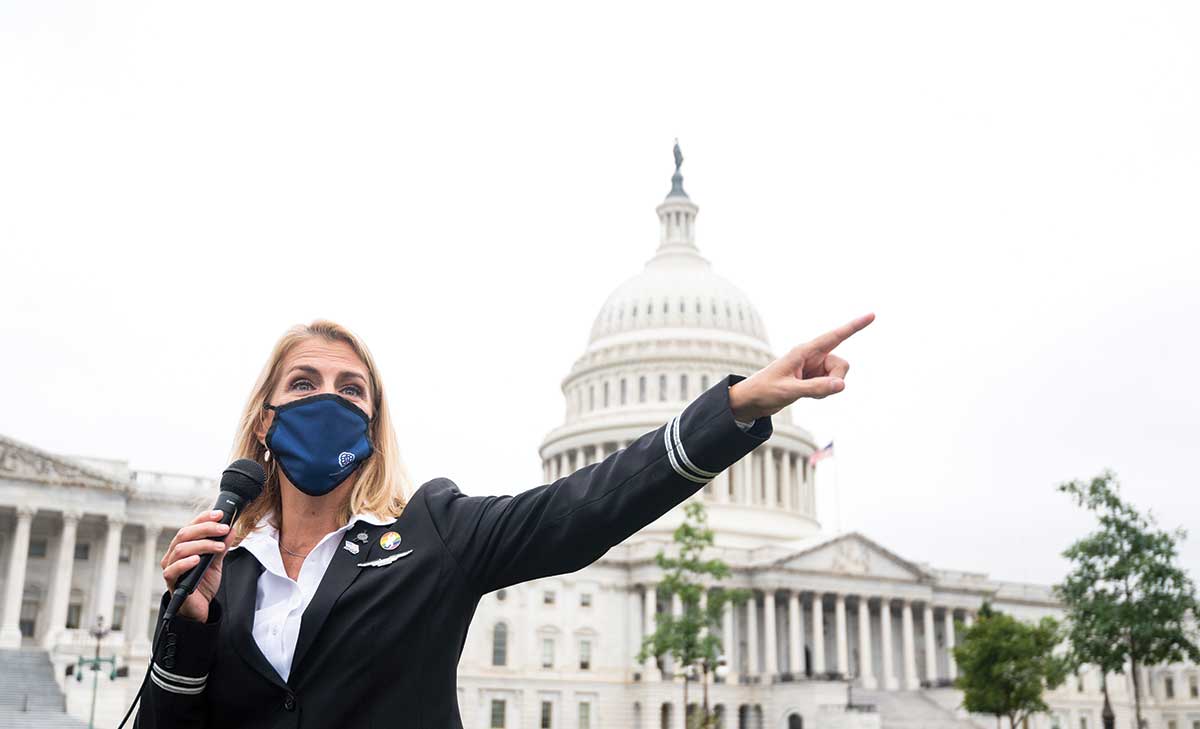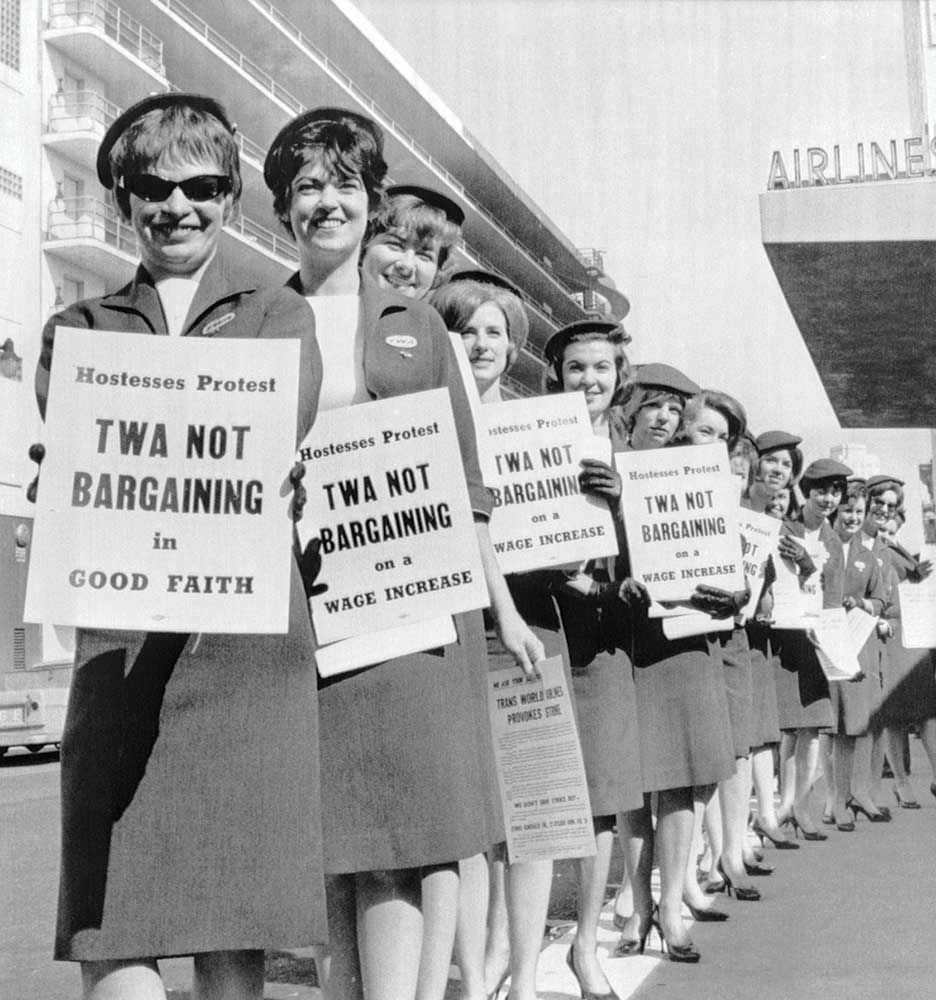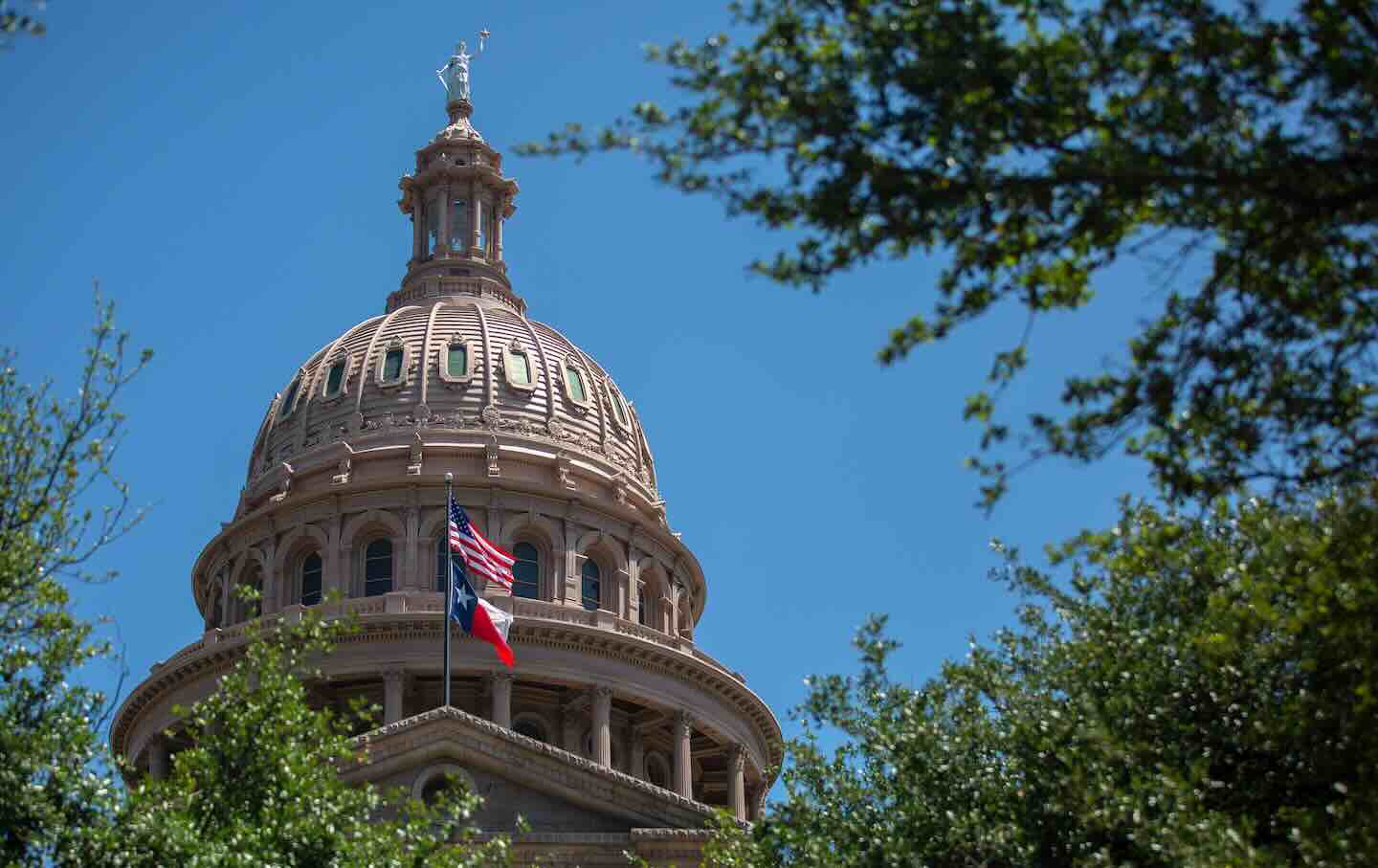Can You Keep Breastfeeding When You Work 30,000 Feet in the Air?
Flight attendants desperately need legal protection to ensure their right to pump on the job—but airline industry lobbying cut them out of a law that will provide just that for millions of workers.

Rachel started working as a flight attendant when she was 24. She wanted to do something fun before she figured out what career to pursue. But despite getting degrees in the years since, she still works as a flight attendant at United. “I just don’t think I could do a 9-to-5 job,” said Rachel (a pseudonym to protect her from retaliation).
Fourteen years later, at 38, she gave birth to a daughter. United allowed her to go on unpaid leave and to keep her health benefits for 90 days, then forced her onto COBRA. Although Rachel had paid her bills ahead of time and put some money into savings, her financial buffer quickly ran out. She returned to work when her daughter was about 4 months old.
Rachel was determined to feed her daughter only breast milk, which meant pumping when she was at work. Each time she flew with new coworkers, she’d explain that she would need time to pump and ask them to cover whatever passenger needs came up during her break. She never knew whether she’d be able to get ice on a flight to keep her milk cold, so she would bring a freezable lunch sack and an ice pack. Rachel tried waiting until after the drink service was over to pump, but “it’d be stressful getting to that point,” she said—sometimes the flight would get delayed or hit turbulence, setting everything back. That’s when her breasts would start to leak or get “hard as a rock.”
Once she was able to take a break, Rachel would go into either the front or back galley and close the curtain, clamping it securely to the oven and compartments. She refused to pump in the lavatory, fearing it was too dirty. She would sanitize the galley and then put the pump underneath her shirt with a sweater over it. If anyone needed something from the galley, she would use one hand to pass it around the curtain. She would pump for 15 to 20 minutes, then pack up her equipment, store her milk, and wipe down the counters.
Then things got even harder. Most of her coworkers were supportive, Rachel said, but a small number were upset by what she was doing. On one flight, a fellow flight attendant bristled at her closing off the galley to pump and reported her to their supervisors. United responded by telling Rachel that she wasn’t allowed to pump on planes and that she would face discipline, and could even be fired, if she continued. Hearing this news, Rachel recalled, “I’m panicking because I’m the breadwinner, I’m the one who holds the insurance, and I’ve got this new baby at home.”
When asked to comment, United spokesperson Charles Hobart said, “We accommodate crew members who are lactating with private areas at bases, airports, and other facilities. We also work with them to find solutions on board aircraft that are consistent with our commitment to safety, health, and well-being for employees and customers.”
Rachel kept pumping on flights, even though she knew she was risking her job. “I was like, ‘You’re not going to tell me how and when or what to feed my baby. You are not going to force me out of breastfeeding—you’re just not.’”
Eighty percent of children are breastfed. Yet workplaces are often hostile and inhospitable to the needs of breastfeeding parents. “The American workplace, in many respects, was built for men and by men,” said Sarah Brafman, the national policy director for the workers’ advocacy organization A Better Balance. “We just do not make American workplaces spaces where someone can both be a parent and work at the same time.”
The stigma and struggles mothers face often start during pregnancy, but they don’t end when the baby is born. “A lot of workers returning from leave encounter a workplace where people think, ‘OK, finally that’s over, now she’s back and we can go back to normal,’” said Gillian Thomas, a senior staff attorney at the ACLU Women’s Rights Project. “There’s less of an understanding of the continuing physiological effects.”
These attitudes can confront parents returning to any workplace, but the barriers can be more acute for low-wage and service-sector workers. They often have rigid schedules or productivity quotas, making it difficult or impossible to take pumping breaks. It’s hard to find a sanitary, private space in cramped quarters like a fast-food restaurant or small retail store. Workers who can more easily be fired and have less power—particularly undocumented workers—risk retaliation. Male-dominated workplaces can be especially fraught because they are already likely to be hostile to female workers. Female-dominated workplaces like schools and hospitals can present their own challenges, because there are few opportunities to take breaks, especially with chronic understaffing.
But even white-collar office workers can struggle. Some may be the first employee to breastfeed. Some employers may genuinely not know how to accommodate an employee who’s pumping. That puts lactating employees in the awkward position of having to explain how their bodies work and what they need. Breastfeeding can be seen as “a choice that a worker is making that’s going to impinge on others,” Thomas said. “It can trigger this new round of resentment.” Workers have been subjected to comments about their bodies and breasts, including being likened to cows or mooed at, and even groped.
The struggle is so acute that many workers are forced to choose between continuing to breastfeed and continuing to work. In a national survey conducted in 2016, half of women said their employment impacted their breastfeeding decisions. Among the 70 lactation discrimination cases tracked by the Center for WorkLife Law between 2008 and 2018, 20 percent of the women were forced to leave their jobs and 43 percent were fired. But conflict between working and breastfeeding is not inevitable. When they’re given the break time and private space to pump, breastfeeding women who have gone back to work are far more likely to continue breastfeeding than those who aren’t given such accommodations.
Popular
“swipe left below to view more authors”Swipe →Formula is an alternative to breastfeeding, and some parents choose to use it out of preference or necessity. But “employers should not dictate how people feed their babies,” said Liz Morris, the deputy director of the Center for WorkLife Law. The national formula shortage may be a factor in some parents’ commitment to breastfeeding; by February of this year, a third of families with infants said they had trouble getting formula.
Though recent books and articles have questioned some of the sweeping claims about the health benefits of breast milk, there is still strong guidance from medical associations to encourage breastfeeding. In 2022, the American Association of Pediatrics updated its recommendations to say that mothers should breastfeed for at least the first two years of their children’s lives. “We have a mismatch between what the health guidance is and what the workplace supports are,” Brafman said.
If a parent does decide to breastfeed, the need to pump while away from a child is unavoidable. Expressing breast milk is a bodily function akin to the need to empty a full bladder. Breastfeeding parents need to nurse or pump regularly or their breasts can become painfully engorged and leak through clothing. Not pumping or nursing as often as needed can lead to infections or mastitis, a painful inflammation of the breast tissue. The inability to pump on the same schedule that a baby would be eating is likely to decrease a parent’s milk supply.
All of the challenges that confront breastfeeding parents are even more fraught for members of flight crews, who have to figure out how to pump while 30,000 feet in the air. Landmark legislation passed at the end of last year will provide new protections for millions more breastfeeding workers. But airline industry lobbyists succeeded in adding a carve-out for flight attendants, leaving them even more vulnerable when their employers make it difficult to pump at work or even ban them from doing so.

For many flight attendants, pumping is inevitable. Many airlines, such as American and Southwest, only offer unpaid leave after the birth of a baby, so flight attendants who haven’t banked enough vacation or sick time often return to work quickly to make an income. Once they’re back on the job, the logistical hurdles compound. Breastfeeding flight attendants often commute long distances to get to their base airport, park in a far-flung parking lot, and have to arrive at the airport one hour before the flight—all of which is time when they aren’t likely to be able to pump. From the time they get on the airplane, about 40 minutes before boarding begins, they are occupied until the last passenger has boarded and the safety demonstration is over. They can’t take breaks during critical phases of the flight, including takeoff and landing, and once the plane levels off, they typically start drink service, which means that they can’t take a break then, either. Only when that’s done can they stop to pump. But even if a flight attendant waits for the right moment, she can face discipline if she is seen as failing to devote all of her attention to the passengers—an outcome that is more likely without any written policy on pumping.
As the plane begins its descent, flight attendants are busy preparing for landing, and then sit down until the plane is safely parked at the gate. Then they attend to the passengers as they deplane. Depending on the timing of their next flight, a flight attendant might have time to pump in the airport, or they might have to rush to the next gate to start the pre-boarding process. All of that assumes that everything goes more or less smoothly; anything from weather to mechanical problems to unruly passengers can delay flights and shift schedules. “You have to pretty much be thinking about when to pump all the time,” said Allie Malis, the government affairs chair for the Association of Professional Flight Attendants (APFA), a union representing American Airlines flight attendants. “It’s like a whole other job.”
As the pressures on flight attendants have increased, pumping has become even more difficult. Flight attendants are expected to work longer days than in the past, with shorter rests between flights. Break times on board have gotten shorter, and galleys have gotten smaller. During the pandemic, when planes were empty, airlines cut their staffing levels down to the minimum set by the Federal Aviation Administration (FAA). But even as the demand for air travel rebounded, “our staffing has not snapped back,” Malis said. Without adequate staff, flight attendants may not get any breaks at all.
The consequences for breastfeeding flight attendants have been dire. A 2021 survey conducted by the Association of Flight Attendants, a CWA union, and the APFA found that 88 percent of their membership didn’t have enough time to pump between flights; 85 percent didn’t have a private place to pump on the plane that wasn’t a lavatory; 60 percent didn’t have a place to wash and sterilize pump parts; and 20 percent didn’t have access to cold storage to store milk. Many flight attendants in Malis’s union have dealt with decreased milk supply and mastitis. Three-quarters of flight attendants in the 2021 AFA and APFA survey said they had to quit breastfeeding earlier than they had planned. Others just quit their jobs.
Airlines for America, an industry lobbying group, said in response to a request for comment that it “supports providing the time and accommodations nursing mothers need to comfortably pump,” adding that “our carriers already voluntarily do so.” And yet some airlines have told flight attendants that they can’t pump at all. In October 2021, Spirit Airlines sent a communication to flight attendants, shared with The Nation by a union representative, that read, “F/As [flight attendants] are not permitted to pump on the aircraft. F/As should plan ahead and identify the location(s) of airport lactation suites, as needed. Currently, there are no federal protections for F/As who might be running late for a flight because they are expressing milk in one of these booths.” Spirit didn’t respond to a request for comment.
Related Article
A recent class-action lawsuit against Frontier Airlines shows how blatant the airlines’ hostility can be to requests to accommodate pumping. When Stacy Rewitzer returned to work for Frontier after giving birth in 2016, she asked about accommodations to allow her to keep breastfeeding, such as a schedule modification or a temporary ground position, according to a lawsuit she and others filed against the airline with the backing of the ACLU. In response, a Frontier employee allegedly asked why she wasn’t resigning in order to keep breastfeeding. When she told the company that it wouldn’t be possible to keep breastfeeding without accommodations, the lawsuit states, Frontier put her on unpaid leave and told her that it “cannot offer any accommodations to nursing flight attendants.” Rewitzer was told she couldn’t return to work until she had no restrictions or need for accommodations, she alleges. She stayed out on unpaid leave for nearly a year.
Melissa Hodgkins, a fellow plaintiff, had to give up breastfeeding entirely after the birth of both of her babies because Frontier wouldn’t work with her, according to the lawsuit. Heather Crowe similarly stopped breastfeeding after Frontier refused to give her a ground position, she alleges.
The lawsuit accuses the airline of banning flight attendants from pumping while at work. It also alleges that Frontier “categorically denied all requested accommodations that would allow flight attendants who are breastfeeding to remain on the job,” then told them that they wouldn’t be permitted to return to work until they no longer needed the accommodations. The parties settled last year, and although Frontier didn’t admit to any liability, it agreed to several policy changes, including allowing flight attendants to pump on flights using wearable breast pumps and accommodating those who can’t fly because of breastfeeding.

Female flight attendants have long faced discrimination on the job. From the early days of commercial air travel, the industry explicitly sought young, attractive women, even setting weight limits and forcing them to quit if they got married. Flight attendants were the first group to file complaints with the Equal Employment Opportunity Commission after it was established in 1965.
Flight attendants won a number of lawsuits against these restrictions in the 1970s, and since then, more and more have worked while starting their families. According to the APFA, nearly 5 percent of American Airlines flight attendants took maternity leave between April 2022 and March 2023.
None of the problems lactating workers face are without solutions, and, in fact, Congress has shown some appetite for addressing them. As part of the passage of 2010’s Affordable Care Act, a provision was attached to the Fair Labor Standards Act (FLSA) that requires certain employers to give their employees reasonable break times to pump and a private, clean space in which to do it for up to a year after childbirth.
However, the scope of that provision has been dramatically, if unintentionally, narrowed. It was inserted in the part of the FLSA that guarantees overtime, which has been so whittled down over the years that less than 7 percent of workers were covered in 2016. As a result, more than 9 million women didn’t qualify, including all teachers, nurses, farmworkers, and flight attendants. It also had no real enforcement mechanism, which led to “widespread noncompliance,” Morris, of the Center for WorkLife Law, said.
This enormous loophole was recently fixed after many years of advocacy. At the end of last year, Congress passed the Providing Urgent Maternal Protections for Nursing Mothers (PUMP) Act, which extends the right to break time and a space to pump to nearly all workers for a year after childbirth. It also gives them the right to file a lawsuit and seek damages if their rights are violated. Employers of all sizes are covered, although those with 50 or fewer employees can claim that compliance poses an undue hardship. Employers must accommodate the pumping schedule that works for the employee’s body. The space provided can’t be a bathroom and must have a place to sit, a flat surface other than a floor, electricity, and somewhere to store breast milk that will keep it cold.
The PUMP Act passed at the eleventh hour—on December 22, just before Congress left for its winter recess—but in the end, 92 senators voted in favor of adding it as an amendment to the year-end omnibus spending bill, with just five voting against, after 59 Republicans supported it in the House.
The only group of workers that won’t get these rights are flight crews, including flight attendants and pilots. The bill originally covered them, while making it clear that pumping would not be accommodated during critical phases of the flight and that planes weren’t required to be retrofitted with new pumping rooms. But the only procedural way to get a vote on the PUMP Act at the end of the year was through unanimous consent, so advocates couldn’t afford to lose a single senator’s vote. And they were up against the airline industry’s “very powerful lobbying core,” said Matt Hettich, a legislative and political representative for the Transport Workers Union of America (TWU). Airlines for America, the industry lobbying group, argued that providing break time and space for pumping could hamper flight safety. (Morris pointed out that airlines haven’t fought, say, pilots’ need to use the bathroom if they have diarrhea, “because men also have diarrhea and we understand that they need to go to the bathroom.”)
Stephanie Pabon’s story shows that it is possible to pump while working as a flight attendant. When I spoke to her, she was about to go back to work and keep breastfeeding for the second time. After she had her first child in 2019, she returned to work for Southwest Airlines when he was 5 months old. She pumped for 10 to 15 minutes every two to three hours. Unlike many other flight attendants, she was willing to pump in a lavatory, which she would wipe down with Clorox. But even more critical than the space was the fact that “everyone was very supportive.” Her employer is “understanding” and “encouraging,” she said.
After the birth of her second child in December, and after taking the full six months of leave allowed by Southwest, Pabon recently went back to work again. “It’s been really easy for me to breastfeed and to pump,” she said. “I do believe that everyone should have the option to breastfeed and pump and be able to support their children that way.”

The airlines floated a compromise on the legislation. Companies were willing to be covered under the federal law so long as they were exempted from state and local lactation laws, according to Morris and Sara Nelson, the AFA president. That followed a trend: They are “fighting tooth and nail to carve themselves out of state labor protections,” Hettich said. Airlines launched two lawsuits in California and Massachusetts arguing that they should be exempt from state labor laws. In Colorado, Southwest recently won a settlement that exempts it from the state’s paid sick leave law, which covers nearly all other employers. Unions successfully fought off a similar attempt at carving flight crews out of a paid sick leave law in Illinois. But fighting the industry’s moneyed lobbying is “kind of David versus Goliath,” Hettich said.
That wasn’t a compromise the unions could accept, and in the end, Senate backers had to ask the unions representing flight attendants to support passing the bill with a carve-out for flight crews or risk getting nothing at all for any of the 9 million workers without protections. “It put flight attendants in a hard place,” the APFA’s Malis said.
But they haven’t given up. “We’re fighting on all fronts: bargaining, legislation, regulatory,” Nelson said. A recent contract secured by the AFA at Alaska Airlines includes language stating that the airline “will make accommodations for lactating Flight Attendants on the aircraft provided it does not interfere with [their] duties and flight schedules,” and the airline also said it would provide private areas at base airports and training centers so long as it doesn’t require spending extra money. “That is a template that could be put in place everywhere,” Nelson said. Meanwhile, the APFA is pushing in its contract negotiations for better staffing, which would make taking breaks to pump more doable. The TWU, for its part, has been trying to extend the length of time that flight attendants can keep their health insurance while on extended family leave.
In May, Senator Jeff Merkley and Representative Val Hoyle introduced the Air Pump Act to require break time and a private place other than a bathroom for flight crew members who need to pump. There is also an effort to include language in this year’s FAA reauthorization requiring the agency to come up with guidance for such workers. Although it has no enforcement power, it could help employers understand that there are ways for flight crew members to safely pump and give employees a better idea of how to make it work.
Rachel, the united airlines flight attendant, ended up connecting with a lawyer at the ACLU. With the attorney’s help, she pushed back against her employer, and eventually the company offered to give her a ground duty position. She was able to pump, but her working schedule changed, which prevented her from continuing to share childcare duties with her husband. He had to go from working five days a week to one. It cost them several thousand dollars, she said. “We definitely paid for it.”
Paid leave would have made a big difference for Rachel, but even some compassion—“if there was more understanding among crew members”—could have gone a long way, she said. She came up with the idea of a detachable curtain that the airlines could give breastfeeding employees to put up over the jump seat or a galley, but the FAA would have to certify it, and United told her it didn’t want to go through the process, she said. A written company policy would have let new parents like her and their coworkers know exactly what to expect and how to do it safely.
Instead, she faced the same roadblocks that flight attendants still have to overcome today. “I still to this day hold it against United,” she said. “It was a really, really tough time.”
“I just battled my way through,” she added. “I’m hardheaded that way. But when it’s for your kids, you’ll do anything.”








